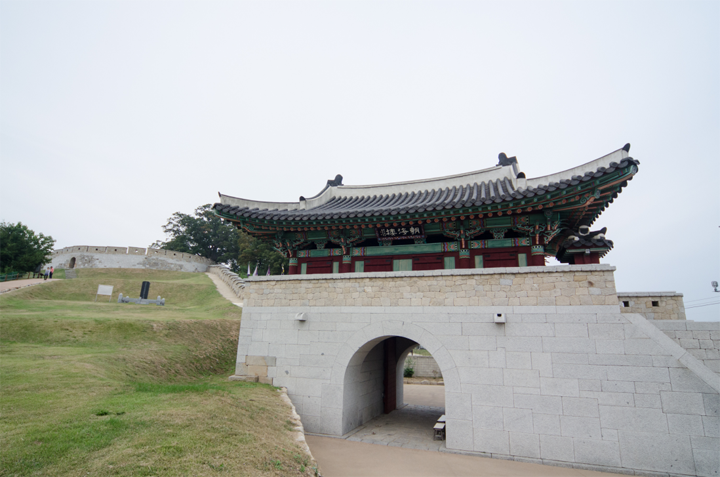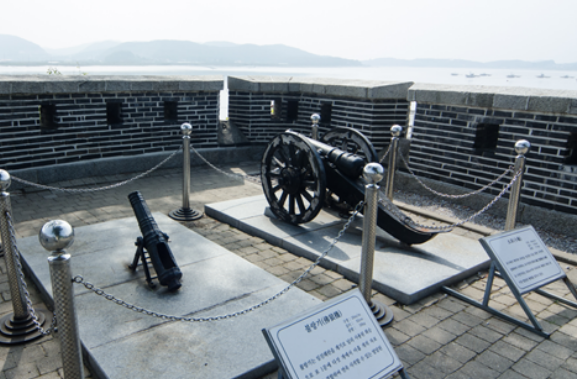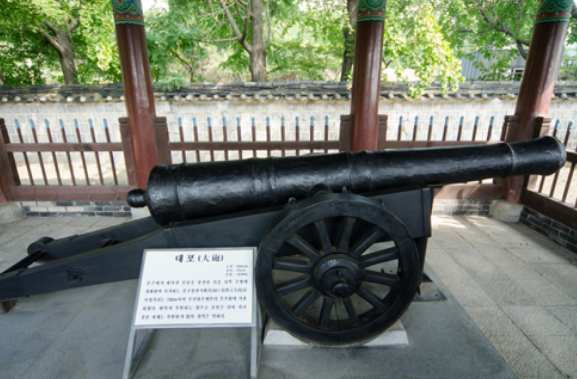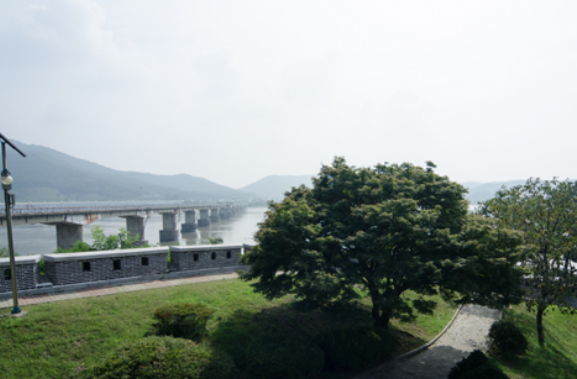
Ganghwado Island in Incheon is a favorite place for getaway in the Seoul Capital Area.
It boasts 'eight scenic views of Ganghwa' including the island's distinctive cultural assets of significant historical values.
Since it is not practical to try to tour all the eight locations in a day, we recommend that you spare two days for a trip to the island for allocating a day to northern Ganghwa and the next day to southern Ganghwa, for instance.
Recommended Tour CourseDay 1: Gapgot Fortification → Yeonmijeong Pavilion → Bomunsa Temple → Jeokseoksa Temple
Day 2: Manisan Mountain → Jeondeungsa Temple → Chojijin Fort → Gwangseongbo Fort
Location of the Eight Sights of Ganghwa

TIP. The Ganghwado Sticker TourThe Ganghwado Sticker Tour refers to a program whereby you make a 'sticker map' with stickers and maps you are given when you purchase tickets for the 12 major tourist spots in Ganghwado Island to earn a gift. Most of the 12 locations are included in the Eight Sights of Ganghwa. The program is particularly popular among children who get motivated to learn about the island's significant historical events.

Day 1Begin with Gapgot Fortification that you will meet as soon as you have crossed Ganghwadaegyo Bridge. Then move on to Yeonmijeong Pavilion. Take a boat to Seokmodo Island to see Bomunsa Temple and finish the first day by enjoying sunset in Jeokseoksa Temple.
Gapgot Fortification

Gapgot Fortification is located on the left as you cross Ganghwadaegyo Bridge from the mainland. It is the gateway to Ganghwa. It was an important fortification in terms of the defense of the Hangang River flowing through Seoul. In 1232, the Goryeo Dynasty moved its capital to Ganghwa and fought fiercely against the Yuan Dynasty that occupied the mainland Korea until 1270. The dynasty struggled to defend the Ganghwa Strait. Then the fortification is said to be equipped with an observation deck called Jinhaeru Pavilion which faced Chwiyeru Pavilion, the western gate of Munsusanseong Fortress across the water.

The Ganghwa War Museum is located within the premises. It is advisable to visit the museum after having a tour of Gapgot Fortification. You can see what kinds of artillery guns and war gear were used in the 13th century in Korea.
Yeonmijeong Pavilion

Yeonmijeong Pavilion is located in Weolgot-ri, Ganghwa-eup, Ganghwa-gun. It was designated by Incheon Metropolitan City as its Tangible Cultural Heritage No. 24 on March 1, 1995. It was named Yeonmijeong (the pavilion of the tail of a swallow) because the water from the Hangang River and Imjingang River meets at this spot before it splits again into the West Sea and the Ganghwa Strait. The roof sits on several high stone pillars. It was built in 1744 (the 20th year of King Yeongjo's reign) and renovated in 1891 (the 28th year of King Gojong's reign) and a few more times later.

Compared to other tourist attractions, the pavilion is less crowded. It is set up in a large lawn surrounded by a fortress wall. It is popular among seniors in the community in summer as the view from the pavilion is quite impressive.
Bomunsa Temple

Sunset in the West Sea is breathtaking from Bomunsa Temple which is located in Seokmodo Island. Take a passenger boat at Oepori Quay in western Ganghwado to go to the island. Bomunsa Temple is one of top 3 Guanyin (the Goddess of Mercy) temples in Korea along with Naksansa Temple in Yangyang and Boriam Hermitage in Geumsan. The temple was built by Queen Seondeok of Silla, who reigned from 632 to 647. The temple buildings such as Gwaneumjeon Hall, Sansingak Shrine, and bell towers are well laid out across the complex. In the front yard of the temple is a big grotto honoring 23 Buddha’s disciples. Legend has it that the they came from the deep sea as they were included in a fishing tackle of a fisherman who was inspired by a mountain god in his dream to cast the net at the spot. The tiny statue that is just 30 centimeters tall looks familiar somehow.

Bomunsa Temple is known for having a host of Buddhists praying for their children's success in important examinations. A Buddha is carved in a cliff. People must have pleaded with him for something as piles of coins are laid beside it.
Don't forget to visit the grotto and see tiny statue inside it.
Jeokseoksa Temple

Jeokseoksan Temple is located not far from the peak of Nakjobong Hill. You can look over Ganghwa Basin from the quiet yard of the temple. You hear just the sound of the wind and birds. Daeungjeon Hall is simple. You might dismiss the temple just as one of the numerous Buddhist temples in Korea. The sunset viewed from temple located in the ridge of Nakjobong Peak is one of the eight scenic views of Ganghwa by the name of 'Jeokseok Nakjo (glow of the setting sun).'
Jeokseoksa Temple was built by an Indian Buddhist Monk Chukbeop of the Goguryeo Kingdom in 416 (the 4th year of King Jangsu' reign), more than 16 centuries ago. The architectural simplicity is understandable.

Be sure to visit the temple in the afternoon so that you will be able to see the setting sun casting an orange glow across the sky.
Day 2Set out on a hike to Manisan Mountain early in the morning. Visit Jeondeungsa Temple. Then go to Chojijin and Gwangseongbo Forts.
Manisan Mountain
Manisan Mountain, standing at 469 meters high, is located in southwestern Ganghwa. It is right at the center of the Korean Peninsula between Baekdusan and Hallasan Mountains. Legend has it that Dangun, the founder of Korea, offered sacrifices to the sky here in Manisan - a proof that it is a celebrated peak; dragons flew into the sky and dragon horses rose from the mountain; and Taoist hermits live in the mountain and the nation's 72nd great leader will come from the mountain. At the top of the mountain is Chamseongdan Altar where the country's founder offered sacrifices to heavens. It is at the altar where the torch is lit for the annual Korean National Sports Festival. The torch for the 1988 Summer Paralympics was lit here as well. There are a couple of courses to the peak. One of them has 918 stairs. You can enjoy the gorgeous view of the West Sea from different angles while climbing the mountain. It is worth visiting the main Buddha hall of Jeongsusa Temple located on the eastern ridge to see the decorative flower-patterned latticed doors, among others.
Manisan is worth a full-day hike.
Of course, going to the peak that is home to Chamseongdan Altar is the best. Yet it is advisable to start early and finish your hike in the morning or to go up to the foot of the mountain if you want to complete the eight scenic view course as scheduled. In the event that you can spend another day in Ganghwa, it would be a good idea to visit the campground called Hamheodongcheon.
Jeondeungsa Temple

Jeondeungsa Temple is Korea's oldest temple that is still standing. It is the symbolic temple advocating 'Buddhism protecting the state' through the abundant grace of Buddha. It has moral authority among the country's Buddhists. Located within the Samnangseong Fortress Wall in Jeongjoksan, the temple is the most significant cultural asset of Ganghwa Island. Jeongjoksan is named after its shape that looks like an upside-down, three-legged caldron.

Jeondeungsa Temple is the most famous in Ganghwa. It is popular among school children for their field trips.
One interesting story is that on the four eaves of the Daeungjeon Hall there are the figures of a naked woman, presumably carved by a broken-hearted carpenter, whom she tricked into handing over all his properties then ran away, with the purpose of giving her a chance to repent and ask for forgiveness for her wrongdoing.
Chojijin Fort

Chojijin Fort was built in 1656 to repel enemies attacking from the sea. In 1679, Jangjapyeong Fortification and Seomam Fortification were constructed and were put under the control of the commander of Chojijin Fort. The fort was the battle site during numerous military confrontations in the late 19th century such as the French Invasion of 1866, the American Expedition in 1871 and the invasion of the Japanese warship Unyo. On June 10, 1871, Rear Admiral John Rodgers of Asiatic Squadron and his 450 soldiers landed in Chojijin and captured several forts including Deokjin and Gwangseongjin. On September 20, 1875, the Chojijin engaged in a fierce artillery battle with the Japanese warship Unyo. Though Chojijin was restored in 1973, there are still traces of cannon attacks on the fort and a pine tree. The fort displays cannons used by the soldiers of the Joseon Dynasty inside the fort.

Once you pass the entrance, walk along the fort and try to go into the spot where guns were placed and look out into the water where the guns must have aimed at.
As one of the most effective forts, Chojijin Fort has plenty of gun emplacements. The fort is easily accessible by car as it is right beside Chojidaegyo Bridge.

Gwangseongbo Fort
Gwangseongbo Fort is the fierce battle site during Sinmiyangyo. On June 10, 1871, Rear Admiral John Rodgers of Asiatic Squadron and his 1,230 soldiers invaded Ganghwado Island with the purpose of establishing trade relations between the USA and the Joseon Dynasty. The U.S. landing troops occupied Chojijin and Deokjin Forts and engaged in a close combat with the soldiers of the dynasty at Gwangseongbo Forts, which had been enhanced as a complete stone forts. Under the leadership of General Eo Jae-yeon, all the soldiers of the Joseon Dynasty fought hard against the invaders despite their inferior weapons. When they ran out of cannon balls, they fought with knives and spears. When their knives and spears broke, they fought with stones and bare hands. All of them perished at the battle.

Gwangseongbo Fort is the largest fort in Ganghwado Island.
Secure enough time when visiting Gwangseongbo to see other historical sites nearby including Gwangseongdondae, Anhaeru, Ssangchungbi and Sondolmokdondae.

The area is excellent to walk around, too, as it has plenty of trees and boasts scenic views in a few places.




